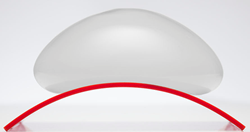
IDEAL IMPLANT Outperforms Silicone Gel Implants at 10 Years
We moved toward silicone gel implants after 2006 because they offered a better cosmetic result over the original, unstructured saline implants. Now we have the Structured Implant technology that offers the similar natural look without MRIs or silent rupture, and the safety of only saline inside.”
DALLAS (PRWEB)
June 17, 2021
Ideal Implant Incorporated today announced the release of its ten-year FDA Core Clinical Trial Data, indicating that the Structured Implant presents a substantially lower risk of two major breast implant complications compared to the silicone gel implants. While silicone gel implants have dominated the industry since they were allowed back on the market in 2006, technological advances over the past decade are now eliminating the need for accepting certain risks associated with silicone gel.
The cumulative risk of implant rupture or deflation with IDEAL IMPLANT over ten years after primary breast augmentation was only 3.7% in comparison to clinical trial data on silicone gel implants from Allergan (9.3%), Mentor (24.2%), and Sientra (8.7%) that had to use MRI scans to detect rupture. When a Structured Implant ruptures, a woman can easily detect partial deflation simply by looking in the mirror, and the multi-chamber design makes full deflation unlikely. Unlike silicone gel, any leaked saline is harmlessly absorbed by the body, and no MRI or ultrasound scan is necessary to detect a rupture.
“This data emphasizes a clear advance in breast implant technology where the old question to patients of ‘do you want saline or silicone gel?’ has become a false choice, since the original, unstructured saline implant does not offer natural results” reports Dr. Larry Nichter, a board-certified plastic surgeon in Southern California and an FDA investigator for the Structured Implant. “We moved toward silicone gel implants after 2006 because they offered a better cosmetic result over the original, unstructured saline implants. Now we have the Structured Implant technology that offers the similar natural look and feel as silicone gel and doesn’t require MRI or ultrasound scans to detect rupture. It eliminates the concern of silent rupture and offers a significantly lower rupture risk, where the saline filler is safely absorbed by the body if there is a leak. In light of this ten-year clinical performance data, the question surgeons should now be asking patients today is, ‘do you want Structured or silicone gel?’”
“Women seeking breast augmentation increasingly are demanding options that don’t require silicone gel to be placed in their bodies, and they have less patience for the risk of silent rupture,” reports Dr. Vivian Ting, a board-certified plastic surgeon in Northern California who presented survey data on women’s implant preferences at the ASPS Aesthetica Super Symposium in 2018. “Too many surgeons—who are predominantly male in this industry—dismiss this trend simply because they are content with the options of the past. Hopefully this data will drive home that they will have fewer ruptures, better outcomes, and happier patients, when they stay current with the technology and patient preferences.”
The IDEAL IMPLANT Structured Breast Implant also outperformed silicone gel implants over ten years in a second major breast implant complication: capsular contracture. After augmentation, the body may form scar tissue around the implant, which can deform the look of the breast and cause pain and firmness. Capsular contracture generally requires revision surgery to remove and replace the implant and scar tissue. IDEAL IMPLANT rates of Baker class III/IV capsular contracture over ten years after primary augmentation were only 6.6%, compared to silicone gel implants from Allergan (18.9%), Mentor (12.1%), and Sientra (12.9%).
“No woman wants to deal with breast implant complications, and this very low rate of capsular contracture directly translates to a lower risk of surgical revisions—and the expense and time associated with that,” explains Dr. Elizabeth Kerner, a board-certified plastic surgeon in the Dallas Fort Worth Metroplex. “A year after surgery, I have to check a patient’s chart to see whether they had silicone gel or the IDEAL IMPLANT, and in my experience, the look and feel is practically identical. While different implants are appropriate for different body types, IDEAL IMPLANT has now demonstrated a superior safety profile while offering the same look and feel as gel. I think we are already seeing this trend follow science as more women demand this choice.”
Dr. Constance Barone, a renowned board-certified plastic surgeon with a busy practice in San Antonio, Texas, confirms this trend. “Demand for the IDEAL IMPLANT is high and growing quickly as women are more educated about the clinical performance data. I ensure all my patients see and feel each one of the current implant options and, almost exclusively these days, they pick the IDEAL IMPLANT.”
The IDEAL IMPLANT Structured Breast Implant began FDA clinical trials in 2009, and received FDA and Health Canada approval for public use in 2014. The company also offers a first-of-its-kind optional Premium Protection Plan, which provides limited financial protection for certain complications related to the procedure and/or the implant, and is renewable for life for greater peace of mind. For more information, visit idealimplant.com.
Share article on social media or email:

